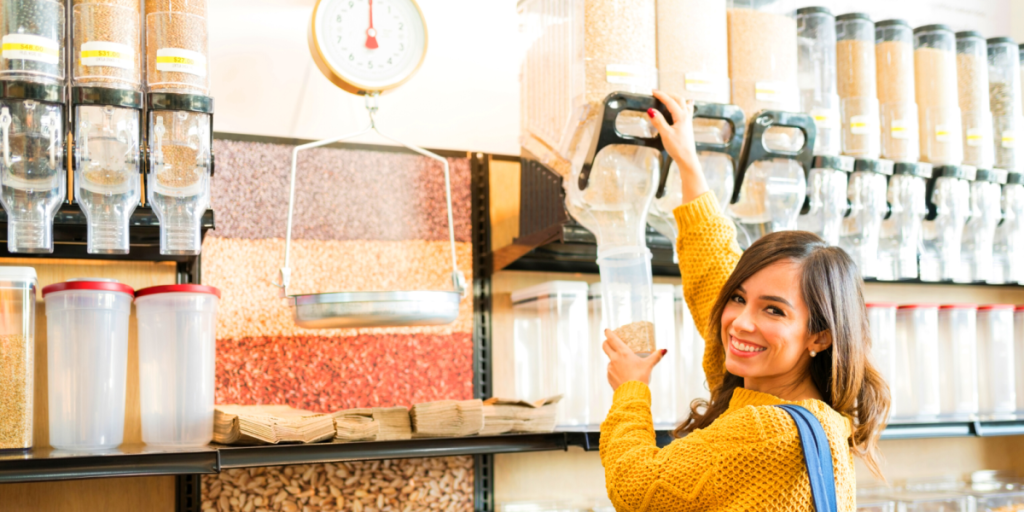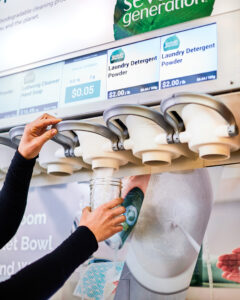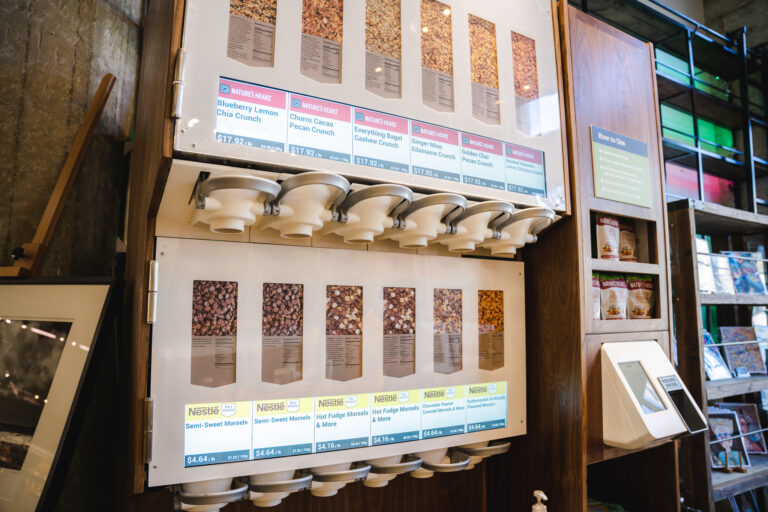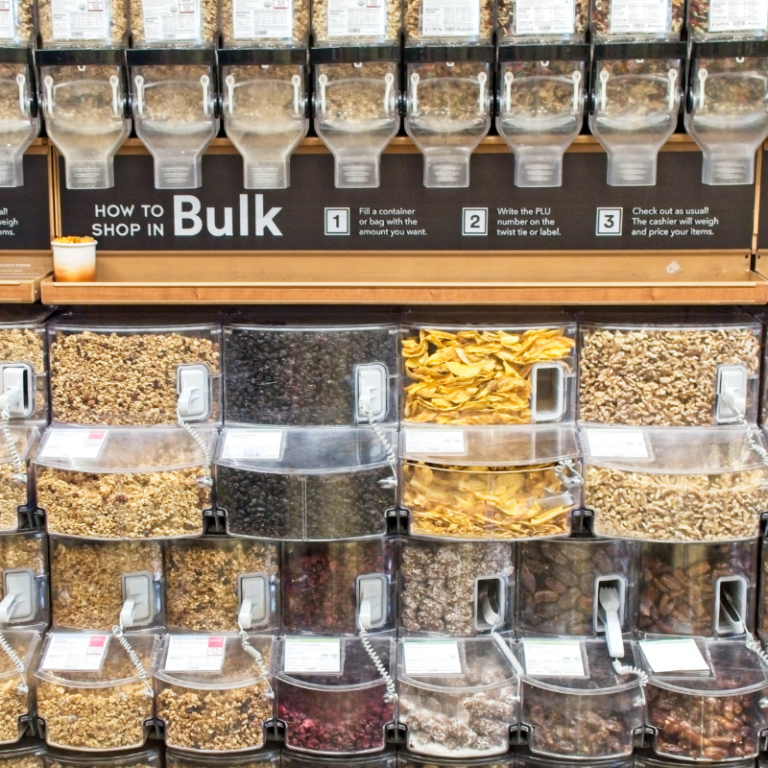
When you think about the most dynamic sections in a grocery store, the bulk foods department may not spring readily to mind. Originally a fixture of natural food stores and co-ops, grocery store bulk departments found their way into mainstream retail but have yet to achieve their full potential.
The pandemic didn’t help matters. Bulk departments, along with a recent wave of “package-less” stores, hit a hard bump in the road early in the COVID-19 epidemic, when the mechanism for the spread of the virus was not understood. Many bulk zones were cordoned off and left to languish for months.
Now, spurred by the growing popularity of low-waste lifestyles and the continued trend toward personalization, bulk is back.
Zero-waste stores, like Brooklyn-based Precycle and Zero Market in Denver, appear to be thriving. In fact, Zero Market reports that it receives nearly 10 inquiries a day from entrepreneurs hoping to replicate their successful zero-waste grocery store model.
While independent retailers have led the zero-waste charge, bigger companies have been paying attention.
Waitrose, known as the Whole Foods of the UK, recently launched Waitrose Unpacked, a specialty store that retails products with low-to-no packaging. Central to its strategy is an enticing array of bulk products.
But even as the concept of zero-waste becomes more important to consumers, most conventional grocery stores with bulk sections still treat them as a dull commodity. Instead, they should be viewed as a strategic asset to engage new customers seeking zero-waste shopping options.
Here are 8 reasons a “packaged at purchase” section deserves pride of place in your sustainable grocery store design or grocery store remodel.
1. Bulk Products Reduce Waste.
Close to 75% of household waste comprises food packaging.
When China changed its policy about the import of recyclable materials from the U.S. in 2018, it shut down close to a third of the market for America’s recyclables. And in recent years, the cost of municipal recycling has gone up astronomically.
Though single-stream recycling has increased recycling rates overall, the quality of the materials has declined because of contamination and damage. Then there’s the energy required to convert these items into usable raw materials, which still has a serious impact on the environment.
But most food packaging never even reaches a recycling bin. For example, 90% of glass placed in the recycling waste stream in the US gets recycled, but only 33% of all glass enters that stream.
Compostable packaging has been coming on strong, but most of these materials can’t break down in household compost bins. And there are few areas where industrial composting waste streams are readily available. Most compostable packaging is ending up in landfills.
When consumers opt for a combination of bulk products and reusable containers, they dramatically reduce the amount of waste they generate, making bulk sections essential to sustainable grocery stores.
2. Bulk Can Be Just As Hygienic As Packaged Products.
Grocery store bulk sections have often struggled with the perception of being less hygienic. Bulk departments were an early casualty of the COVID-19 pandemic, as shoppers obsessed over surface cleanliness.
However, gravity bins dispense product without customers having to open bins and scoop out product. Beyond discouraging the spread of pathogens, gravity bins can help reduce the release of allergens, especially if grocers are intentional about using dedicated equipment and putting procedures in place to prevent cross contamination.
3. Bulk is Getting a Boost from New Technology.

Purcell’s new dispensing technology promises to streamline the bulk shopping experience.
Zero-waste retailing has caught the attention of new players. An innovator in this space, Santa Cruz, California-based Purcell, has brought Silicon Valley engineering knowhow to these traditionally stodgy fixtures. (Here’s a short video of their system in action.)
Purcell’s S1 Dispenser uses a touchless, silver ion Ag+ infused antimicrobial nozzle and touch-free controls. The S1’s labor-saving system features plug-in loading of product-filled cartridges. This helps ensure a fresher, longer lasting product.
4. Grocery Store Bulk Zones Deliver More Sales Per Square Foot.
Bulk bins are an intensive use of expensive retail real estate, offering grocery stores the ability to stock twice as much product by weight as they could in the same amount of space dedicated to conventional packaged goods.
Bulk fits beautifully into the consumer trend toward “shopping small” and patronizing independent businesses. Neighborhood grocery stores with small footprints, especially urban grocery stores, can carry more inventory in a bulk zone than they could on conventional shelves.
Grocery stores don’t have to make a major commitment. Instead, they can experiment with a modest bulk zone and expand it, thanks to the modular nature of these systems.
5. Bulk Product Sales Deliver Higher Profit Margins to Retailers and Lower Prices for Consumers.
Bulk Reduces Packaging Costs.
Food packaging is expensive, estimated to comprise at least 7-10% of the cost of most products. Bulk enables grocers to increase profit margins while lowering price points for shoppers.
Consumers Can Buy Only What They Need.
Another advantage of bulk for shoppers: it enables them to buy exactly the amount they need without forcing them to pay more per ounce for a smaller quantity.
Rather than having to settle for quantities dictated by the manufacturer, the experience of buying bulk makes consumption more mindful.
Beyond being budget friendly, this reduces waste from food spoilage at home: according to Foodprint.org, uneaten food is the single largest component of municipal solid waste. And that’s not the entire sustainability upside—wasted food breaks down in landfills and forms the greenhouse gas methane.
A well-designed bulk zone creates the feeling of being in a marketplace, and discovering new and even exotic things. It puts the emphasis back on the product, not the packaging.
Sara Luke, KRS Senior Designer
6. Bulk Bins Can Reduce Grocery Store Labor Costs.
Refilling bulk bins is less time-consuming than stocking packaged products. With the current labor shortage showing no signs of abating, bulk offers the opportunity for increased efficiency and profit.
7. Bulk Offers New Ways to Celebrate Local Producers...and to Reposition Brands.
Innovative grocers are promoting the products of local producers who don’t operate on a large enough scale to work with a co-packer.
Locally produced products that are bulk-friendly include nuts, snack mixes, dried fruit, honey, grains (such as heritage wheat varieties and popping corn), freeze-dried fruits and veggies, dried herbs, coffee beans, and artisan teas.
This gives retailers the opportunity to celebrate local producers, cultivate loyalty, and differentiate their offerings from national competitors.
But brands wishing to offer a zero-waste alternative are launching bulk offerings, too. It’s not just the Seventh Generations of the world…Nestle is selling branded bulk chocolate, too.
However, the FDA itself states that the food code is a model “offered for adoption” by state and local agencies. Retailers should study their own local health department codes regarding the use of refillable containers for purchasing bulk.
Elroy’s Fine Foods in Monterey, California features a beautiful, full service, chef-selected bulk section adjacent to its produce department, which “offers a superb array of grains, flours, nuts and nut butters, seeds, dried beans, oils and vinegars, salts and peppers, custom tea and spice blends, and adaptogens.”

8. Bulk Builds Customer Loyalty.
Natural Foods Merchandiser Magazine ranked bulk foods second overall in the Signature Product Categories that need to be offered in a natural foods store. The same publication reported that “if the bulk section was removed from their favorite store, over 60 percent of naturals shoppers would go elsewhere.”
Loyal bulk shoppers also know that buying bulk instead of pre-packaged foods can often save them money, though savings vary widely between products.
Exploring and selecting bulk products is more interactive and experiential than taking a package off a shelf. This helps create a deeper emotional connection for customers.
9. Bulk is Not Just for Food.
Natural cleaning products like dish soap and vinegar are perfect bulk offerings. High-margin personal care products like hair care, body lotions, dry shampoo, and skin care products can also be sold in bulk.
Though consumers are accustomed to endless aisles of choices in consumer packaged goods, a curated, focused array of more sustainable, natural products can compete successfully against the dubious benefit of excessive “choice”—and excessive packaging.
Addressing Bulk’s Biggest Bugaboos.
Challenge: Grocery Store Bulk Sections are Vulnerable to Shrinkage.
Shrink, both accidental and intentional, has always plagued bulk departments. Customers accidentally write down the wrong product number; cashiers mis-read labels. And sneaky shoppers can substitute the code for a cheaper product. Shrink also occurs when products spill.
Purcell’s Smart Bins are designed to end shrinkage by automating the dispensing process. With a sleek user interface, the system quickly prints labels for the customer’s selections.
Another approach that’s gaining steam is a full-service bulk department. This harkens back to the old dry goods store with a clerk behind the counter who expertly weighs, packages, and prices products. While this does require an employee to assist shoppers, it also presents the opportunity to educate the customer and to make additional suggestions of new products to try.
Challenge: BPA In Plastic Bulk Bins.
Bisphenol A (BPA) is a chemical used to harden plastic. Early bulk bins were often made of hard plastics, including polycarbonate, that were later found to leach BPA when exposed to liquids. Dry products stored in this type of plastic do not appear to absorb BPA.
BPA-free material solutions include new eco-friendlier plastics, glass, and stainless steel. Glass and steel dramatically increase the cost of building a bulk area, but these materials hold up well under heavy use and frequent cleaning. Acrylic plastic scratches and “fogs” if the wrong cleaning materials are used.
Ready to elevate
your grocery store?
Challenge: Containers.
Many grocery store bulk sections still provide paper, plastic, or compostable bags, which defeats the “packageless” purpose. Zero-waste lifestyle customers prefer to bring their own reusable containers to fill.
Some stores offer a “library” system where containers can be checked out and returned. Others sell branded, reusable containers. For stores to encourage the adoption of packaged-at-purchase, they need to remove barriers and make the shopping process as simple as possible.
When a customer brings their own container, the retailer must establish its specific “tare”, or empty weight. The tare weight is then subtracted from the total weight at checkout.
Purcell’s SmartBin is on a mission to eliminate the weighing conundrum altogether. It calculates the weight and price of the product as it’s dispensed, regardless of what container it’s being dispensed into.
Rethinking Refills.
Karine Vann, in her Civil Eats article, U.S. Supermarkets are Doing Bulk All Wrong, notes that Whole Foods and many other grocers who believe the law prevents them from allowing customers to bring their own containers, citing FDA (U.S. Food & Drug Administration) Code.
As the zero-waste lifestyle gains prominence, restrictive policies will surely meet new challenges from consumers who demand a true, no-waste bulk option. In a few cases, zero-waste retailers have successfully challenged local food safety rules with education and activism.
Designing Grocery Store Bulk Departments.
The next-gen bulk department design strategy takes the old model of undifferentiated, generic offerings and turns it on its head, creating excitement, demand, and loyalty.
Rather than being dull, “bulk can evoke a nostalgic shopping experience”, says Sarah Luker, a senior designer at King Retail Solutions. She recently completed two new projects in California that put a fresh spin on bulk.
“A well-designed bulk zone creates the feeling of being in a marketplace, and discovering new and even exotic things,” she says. “It puts the emphasis back on the product, not the packaging. The shopper can really see the product that they’re buying.”
This highlights their color and texture, and encourages impulse purchases. “Bulk foods are a great way to re-learn about food traditions we’ve forgotten.”
Tactics for Integrating Bulk Products Into a Store Layout
[Need more help with your store layout? Read our 7 Store Planning Strategies for a Customer-Centric Experience.]
Position a bulk zone with a clear line of sight to the produce department.
“These two departments can really ‘talk’ to one another,” Luker says. “And because produce departments tend to have more staff, it’s helpful for reducing shrinkage.”
Merchandise bulk next to packaged goods in the same category.
For example, place a bulk “baking” zone alongside packaged flours, sugar and other dry ingredients. The same thing can be done with bulk beauty products. “If we make it easy and interesting,” Luker explains, “people will try it.”
Create purposeful bulk areas throughout the store—eliminate the traditional, monolithic bulk zone.
This design strategy also increases perceived value. When everything “bulk” is merchandised together it can make the products feel generic. Luker observes, “It’s important to put bulk in the shopper’s path,” and not relegate it to lower traffic areas.
Make sure you have a cleaning and sanitation strategy.
“Bulk can be messy,” Luker notes. “Things spill.” Most bulk dispensers include trays to catch spills, but overflow can be an issue, especially with gravity bins. Bulk manufacturer Rosetto manufactures bins with a patented portion wheel that allows for quick and portioned dispensing.
Use plenty of messaging to reinforce the benefits of bulk.

Luker recommends an integrated signage strategy for bulk zones. “Make sure customers know the ‘why’ behind it—sustainability, freshness, personalization.”
But customers new to bulk also need to understand the “how.” Clear signage with step-by-step instructions will help ease them into buying “packaged at purchase” products.
A Bulky Future.
The plastic pollution crisis is not abating, and single-use containers are still the norm. But the dire environmental consequences of this type of consumption are finally hitting home for many shoppers.
While true zero-waste grocery stores are still small in number and scale, natural foods and sustainable living are becoming increasingly important to mainstream shoppers. Bulk departments are ready to become a key component—and even the stars—of the next-generation grocery store.
